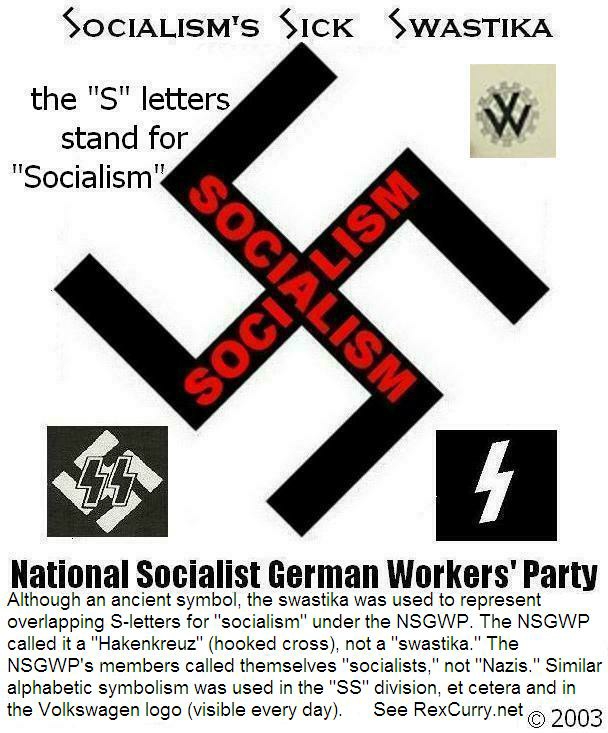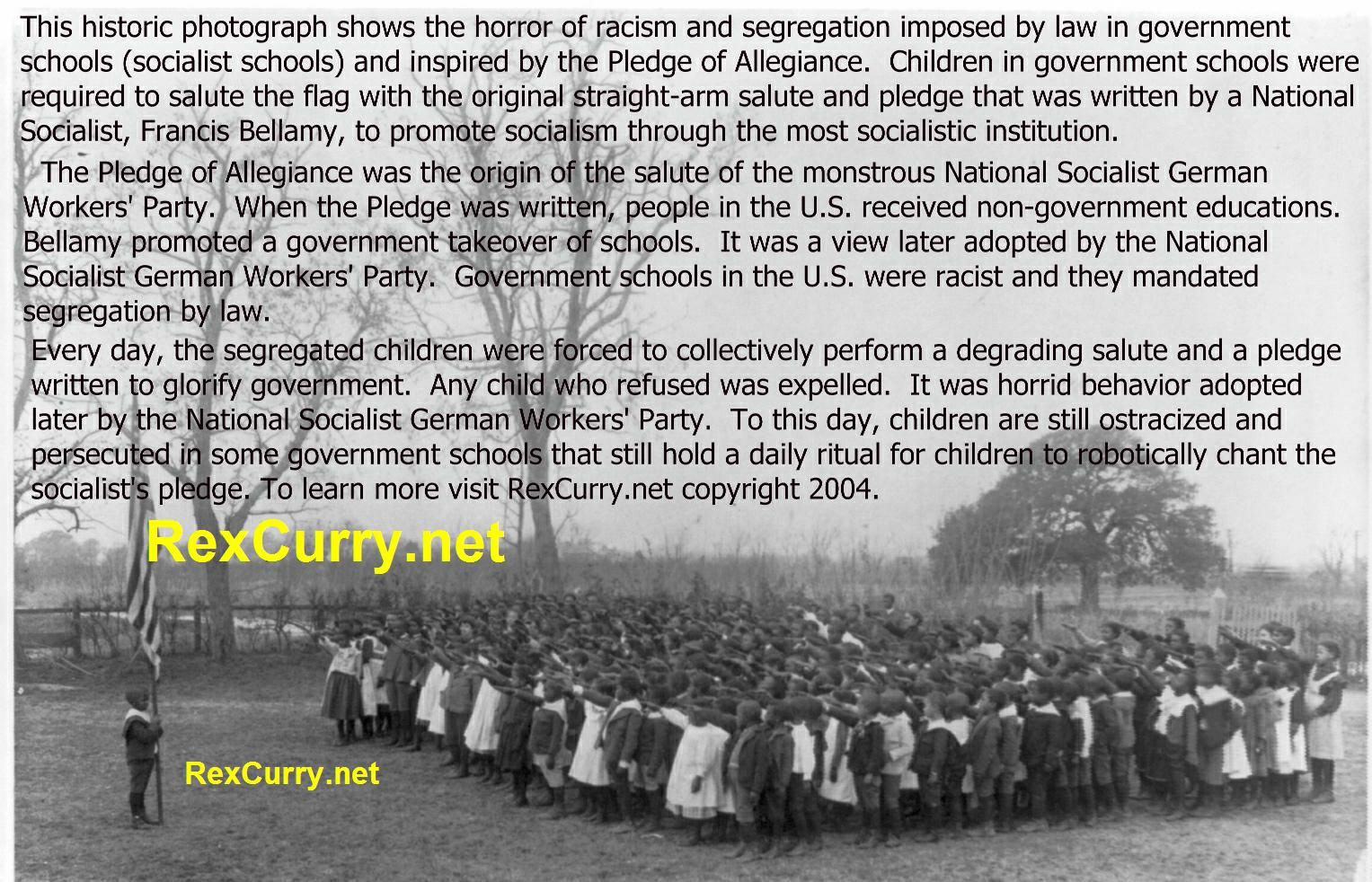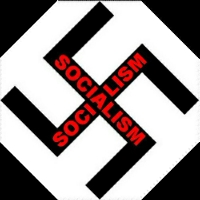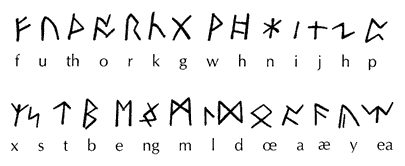Toland asserts that when the leader of the National Socialist German Workers’ Party adopted the swastika, it was already in use as a symbol for a socialist group, a fact known by Hitler when selecting the symbol.
Toland provides no footnote or reference for his claim, and it is unfortunate that Toland died in 2004 and cannot be asked for details about the earlier Party’s use of the swastika.
On page 105 Toland writes "Finally, a dentist from Starnberg submitted a flag which had been used at the foundiing meeting of his own party local: a swastika against a black-white-red background."
Another entry in Toland’s book (p 183) makes reference to Hans Knirsch, founder of the National Socialist Workers Party in Czeckoslovakia also known as the Sudetendeutsche National Sozialistische Partei or Sudeten-German National Socialist Party.
If the swastika was a symbol of the Sudetendeutsche National Sozialistische Partei, then it provides another interpretation for the swastika's two overlapping "S" letters: "Sudeten Socialism" or even "Southern Socialism." The word "Sudeten" came to mean "Southern" for many Germans, even though the original etymology is unclear.
The German Army marched into the Sudetenland on 1st October, 1938. Before that date (on 29th September, 1938), Adolf Hitler, Neville Chamberlain, Edouard Daladier and Benito Mussolini signed the Munich Agreement which transferred the Sudetenland to Germany. When Eduard Benes, Czechoslovakia's head of state, protested at this decision, Neville Chamberlain told him that Britain would be unwilling to go to war over the issue of the Sudetenland. Neville Chamberlain and Edouard Daladier agreed that Germany could have the Sudetenland because they were desperate to avoid war, and anxious to avoid an alliance with Joseph Stalin and the Union of Soviet Socialist Republics. In return, Hitler promised not to make any further territorial demands in Europe.
On August 23, 1939, the Union of Soviet Socialist Republics formed an alliance with the National Socialist German Workers' Party to invade Poland and divide up Europe. The National Socialist German Workers’ Party invaded Poland first (Sept. 1, 1939), followed shortly thereafter (Sept. 17) by the Union of Soviet Socialist Republics. In that partnership, the Union of Soviet Socialist Republics slaughtered more people in Poland than did the National Socialist German Workers' Party.
The written partnership partitioned not only Poland (along the line of the Vistula) but much of Eastern Europe. The Union of Soviet Socialist Republics took Finland, Estonia, Latvia, and Bessarabia; the National Socialist German Workers’ Party took everything to the West of these regions, including Lithuania. Each was to ask the other no questions about the disposition of its own ''sphere of interest." This alliance was coupled with a trade treaty and arrangements for large-scale exchange of raw materials and armaments.
On September 28, 1939 the Boundary and Friendship Treaty between the Union of Soviet Socialist Republics and the National Socialist German Workers Party was supplemented by secret protocols to amend the secret protocols of Aug 23rd. Among other things Lithuania was reassigned to the Soviet sphere of influence. Poland’s partition line was moved eastwards from the Vistula line to the line of the Bug. Germany kept a small part of south-west Lithuania, the Uznemune region. A separate Soviet mutual defense pact was signed with Estonia that allowed 25,000 Soviet troops to be stationed there.
The origin of the National Socialist GermanWorkers Party involved Hans Knirsch (September 14, 1877 - December 6, 1933), a Moravian activist for Austrian National Socialism. After the breakup of the Austrian Hungarian Empire, Knirsch led the original mother party in Czechoslovakia, at that time in Bohemia called the Sudeten German National Socialist Party. Knirsch, with Rudolf Jung and Hans Krebs, was one of the original core of National Socialists that remained in the National Socialist German Workers’ Party after 1933.
The Sudetendeutsche Nationalsozialistische Partei or Sudeten-German National Socialist Party was created when the new state of Czechoslovakia outlawed the DNSAP, the "German National Socialist Workers Party". At the end of WWI, the Austro-Hungarian Empire broke up into its particular nation states and the new Czech dominated government considered the Pan-German party to be offensive. The Sudeten Germans created the German Workers Parties (DAP's) that developed under the old empire in Bohemia and Moravia and they originated Austrian National Socialism. Hans Knirsch was their leader from 1918 to 1933, when he was succeeded by Konrad Henlein.
Knirsch was involved with Franko Stein of Eger (Cheb) and Ludwig Vogel of Brüx, who organized the Deutschnationaler Arbeiterbund (German National Workers' League) in 1893. In 1899, Stein was able to convene a workers' congress in Eger and promulgated a 25-point program. In Aussig, on November 15, 1903, they reorganized with the new name of "Deutsche Arbeiterpartei in Österreich" (DAP) - the "German Workers' Party in Austria." At other party congresses, Hans Knirsch also proposed a name change to "Nationalsozialistische" (National-Socialist) or "Deutsch" (German) Workers' Party. Thus, before WWI, Knirsch was unsuccessful in getting the DAP to add the words "National Socialist" to their name.
The National Socialist Program (also known as the 25-point program) was copied later by the National Socialist German Workers’ Party. It was first formulated in Vienna, at a German Workers’ Party congress, and was brought to Munich by Rudolf Jung, who was deported from Czechoslovakia. Josef Pfitzner, a Sudetenland author, stated "the synthesis of the two great dynamic powers of the century, of the socialist and national idea, had been perfected in the German borderlands [i.e. Sudetenland] which thus were far ahead of their motherland."
Czeckoslovakia and Austria did not exist as separate countries when the program was written. They existed under the Austro-Hungarian Empire. The programs of the Sudetenland and Austrian National Socialists developed under the Habsburg monarchy, in a single country at that time. Different German worker parties developed in Vienna, Aussig, and Eger. Hitler and many of his cohorts were not involved in the creation of the original National Socialist programs.
Toland also notes that the swastika was long a symbol of the Teutonic Knights and had been used by Lanz Von Liebenfels, the Thule Society and a number of Free Corps units before it took on it socialist symbolism.
Anton Drexler (June 13, 1884 - February 24, 1942) was a Munich locksmith and member of the völkisch agitators who, together with journalist Karl Harrer, founded the German Workers' Party (DAP) in 1919. The name of the party was changed to the National Socialist German Workers' Party (NSDAP) early in 1920. Drexler was also a member of a völkisch political club for affluent members of Munich society known as the Thule Society.
The Germanenorden was a group in Germany early in the 20th century. Formed in 1912, the order, whose symbol was a swastika. It taught to its initiates socialist ideologies. Some people theorize that the Deutsche Arbeiter-Partei (later the National Socialist German Workers’ Party (Nazis)) became a political front for the group, because the group reflected many ideas of the party, including the swastika symbol. The Thule Society had similar ideas and symbols and was closely linked.
One argument claims that the swastika was chosen due to German myths or confusion about Indo-Aryan or Indo-Iranian heritage. There is no support for that argument. But if that argument is correct then it supports the double-S for "socialism." If Nazis used the swastika to claim an Indo-Aryan heritage, then they saw that heritage evidenced in ancient Germanic runes for the letter "S" and for their support of socialism.
As an even earlier symbol in Sanskrit, the swastika means "all is all" which eerily supports a symbol for totalitarian socialism.
The swastika has also been interpreted as "good luck," or literally "it is good" (Sanskrit is the oldest extant Indo-Aryan language retained in India) and that fit the National Socialist view of merging all socialist groups into one large organization.
In ancient times, the symbol might have also represented the sun or a wheel, thus giving rise to the modern terms "socialist sun" and "wheel of socialism" and the "circle of socialism" for the swastika of socialism.
If the swastika had any "Aryan" etymology to Nazis it was in the dictionary's second meaning: "noble" or "high rank." They used it to mean a "master race" or "noble class" or "ruling class." That ties into the swastika as a "superman" emblem for the cockamamy "super socialist man." That utopian totalitarianism is consistent with the book "Looking Backward" by Bellamy and with other totalitarian socialist societies: the Union of Soviet Socialist Republics (62 million dead) and the Peoples' Republic of China (35 million dead).
For National Socialists, "Aryan" meant the people they liked or, in other words, the people that they didn't hate.
Aryan is an English word derived from Sanskrit term “arya,” meaning “high rank” (adj.), "noble" (n) + an. The word “swastika” is also from Sanskrit. It refers to a speaker of the languages ancestral to the Indo-Aryan or the Indo-Iranian languages. The term “Iranian” is related to the word “Aryan.” Imagine the word "Aryan" as "Aran" to see the similarity to "Iran" (Persia).
Aryan is an adjective to the root *ar-, originally meaning 'to assemble', possibly with positive overtones of "accomplished, skillful". *aryo- as the name of a people, the "Aryans", is only attested in India and Persia, but the root is well known from other languages in the Indo-European world, e.g. the aristoi, the "most noble," of Greece, (cf. Aristotle, aristocracy, aristocrat) and possibly Éire, the Irish name of Ireland (although this is not commonly accepted). The original meaning of the root, pertaining to skillful assembly, union, confederacy, may be perceived, for example in Latin ars "art" and ordo "order" or in Greek harma "chariot". Also see “arch” a combining form used to create nouns that denote individuals or institutions directing or having authority over others of their class (archbishop; archdiocese; archangel); also meaning “principal” (archenemy, archrival) or “prototypical” and thus exemplary or extreme (archconservative), also compare architect, archetype.
The leader of the National Socialist GermanWorkers Party had this to say about the swastika (in Mein Kampf):
"I myself was always for keeping the old colours, not only because I, as a soldier, regarded them as my most sacred possession, but because in their aesthetic effect, they conformed more than anything else to my personal taste. Accordingly I had to discard all the innumerable suggestions and designs which had been proposed for the new movement, among which were many that had incorporated the swastika into the old colours. I, as leader, was unwilling to make public my own design, as it was possible that someone else could come forward with a design just as good, if not better, than my own. As a matter of fact, a dental surgeon from Starnberg submitted a good design very similar to mine, with only one mistake, in that his swastika with curved corners was set upon a white background.
After innumerable trials I decided upon a final form – a flag of red material with a white disc bearing in its centre a black swastika. After many trials I obtained the correct proportions between the dimensions of the flag and of the white central disc, as well as that of the swastika. And this is how it has remained ever since.
At the same time we immediately ordered the corresponding armlets for our squad of men who kept order at meetings, armlets of red material, a central white disc with the black swastika upon it. Herr Füss, a Munich goldsmith, supplied the first practical and permanent design.
The new flag appeared in public in the midsummer of 1920. It suited our movement admirably, both being new and young. Not a soul had seen this flag before; its effect at that time was something akin to that of a blazing torch. We ourselves experienced almost a boyish delight when one of the ladies of the party who had been entrusted with the making of the flag finally handed it over to us. And a few months later those of us in Munich were in possession of six of these flags. The steadily increasing strength of our hall guards was a main factor in popularizing the symbol.
And indeed a symbol it proved to be.
Not only because it incorporated those revered colours expressive of our homage to the glorious past and which once brought so much honour to the German nation, but this symbol was also an eloquent expression of the will behind the movement. We National Socialists regarded our flag as being the embodiment of our party programme. The red expressed the social thought underlying the movement. White the national thought. And the swastika signified the mission allotted to us – the struggle for the victory of Aryan mankind and at the same time the triumph of the ideal of creative work......
Two years later, when our squad of hall guards had long since grown into storm detachments, it seemed necessary to give this defensive organization of a young Weltanschhauung a particular symbol of victory, namely a Standard. I also designed this and entrusted the execution of it to an old party comrade, Herr Gahr, who was a goldsmith. Ever since that time this Standard has been the distinctive token of the National Socialist struggle.
The above in the German language of Mein Kampf
{556 Die nationalsozialistische Flagge}
Entwurf an die Öffentlichkeit treten, da es ja möglich war, daß ein anderer einen ebenso guten oder vielleicht auch besseren bringen würde. Tatsächlich hat ein Zahnarzt aus Starnberg auch einen gar nicht schlechten Entwurf geliefert, der übrigens dem meinen ziemlich nahekam, nur den einen Fehler hatte, daß das Hakenkreuz mit gebogenen Haken in eine weiße Scheibe hineinkomponiert war.
Ich selbst hatte unterdes nach unzähligen Versuchen eine endgültige Form niedergelegt: eine Fahne aus rotem Grundtuch mit einer weißen Scheibe und in deren Mitte ein schwarzes Hakenkreuz. Nach langen Versuchen fand ich auch ein bestimmtes Verhältnis zwischen der Größe der Fahne und der Größe der weißen Scheibe sowie der Form und Stärke des Hakenkreuzes.
Und dabei ist es dann geblieben.
In gleichem Sinne wurden nun sofort Armbinden für die Ordnungsmannschaften in Auftrag gegeben, und zwar eine rote Binde, auf der sich ebenfalls die weiße Scheibe mit schwarzem Hakenkreuz befindet.
Auch das Parteiabzeichen wurde nach gleichen Richtlinien entworfen: eine weiße Scheibe auf rotem Felde und in der Mitte das Hakenkreuz. Ein Münchner Goldschmied, Füß, lieferte den ersten verwendbaren und dann auch beibehaltenen Entwurf.
Im Hochsommer 1920 kam zum ersten Male die neue Flagge vor die Öffentlichkeit. Sie paßte vorzüglich zu unserer jungen Bewegung. So wie diese jung und neu war, war sie es auch. Kein Mensch hatte sie vorher je gesehen; sie wirkte damals wie eine Brandfackel. Wir selber empfanden alle eine fast kindliche Freude, als eine treue Parteigenossin den Entwurf zum ersten Male ausgeführt und die Fahne abgeliefert hatte. Schon einige Monate später besaßen wir in München ein halbes Dutzend davon, und die immer mehr und mehr um sich greifende Ordnertruppe besonders trug dazu bei, das neue Symbol der Bewegung zu verbreiten.
Und ein Symbol ist dies wahrlich! Nicht nur, daß durch die einzigen, von uns allen heißgeliebten Farben,
{557 Deutung des nationalsozialistischen Symbols}
die einst dem deutschen Volke soviel Ehre errungen hatten, unsere Ehrfurcht vor der Vergangenheit bezeugt wird, sie war auch die beste Verkörperung des Wollens der Bewegung. Als nationale Sozialisten sehen wir in unserer Flagge unser Programm. Im Rot sehen wir den sozialen Gedanken der Bewegung, im Weiß den nationalistischen, im Hakenkreuz die Mission des Kampfes für den Sieg des arischen Menschen und zugleich mit ihm auch den Sieg des Gedankens der schaffenden Arbeit, die selbst ewig antisemitisch war und antisemitisch sein wird.
Zwei Jahre später, als aus der Ordnertruppe schon längst eine viel tausend Mann umfassende Sturmabteilung geworden war, schien es nötig, dieser Wehrorganisation der jungen Weltanschauung noch ein besonderes Symbol des Sieges zu geben: die Standarte. Auch sie habe ich selbst entworfen und dann einem alten, treuen Parteigenossen, dem Goldschmiedmeister Gahr, zur Ausführung übergeben. Seitdem gehört die Standarte zu den Wahr- und Feldzeichen des nationalsozialistischen Kampfes.
Internet searches reveal that Http://rexcurry.net is the trendsetter again as the site that originated and used the following phrases below on the web or in groups about the sick socialist swastika's meaning for the National Socialist German Workers' Party. In ancient times, the swastika symbol might have also represented the sun or a wheel, thus giving rise to the modern terms "socialist sun" and "wheel of socialism" and the "circle of socialism" and "swastika of socialism" all terms that were first used on the internet by rexcurry.net. It is remarkable that these philosophical points have never been made before. To see visual evidence visit http://rexcurry.net/swastikanews.html And http://rexcurry.net/swastikamain.htmlSanskrit spread from northern India across the sub-continent, largely on the back of Hinduism, and then - though no one quite knows how - to southeast Asia. Codified 2,500 years ago and barely changed since, this was a language that took great pleasure in its own beauty, which was intimately bound up with an Indian worldview, but which was ultimately to ossify to such an extent that today, although still an official language of India, it is spoken by fewer than 200,000 people.
SIEG RUNE Image http://rexcurry.net/swastika3swastika.jpg SOWELO RUNE Photograph

SOWILO GERMAN RUNES Image http://rexcurry.net/swastika3swastika.jpg RUNOLOGY Photograph
ADOLF HITLER SALUTE Image http://rexcurry.net/pledge-allegiance-pledge-allegiance.jpg SYMBOLOGIST DR. REX CURRY Photograph

National Socialism Image http://rexcurry.net/pledge-allegiance-pledge-allegiance.jpg German National Socialist origins Photograph



